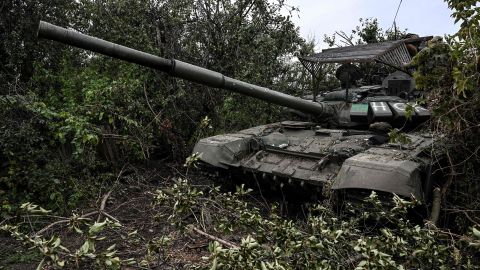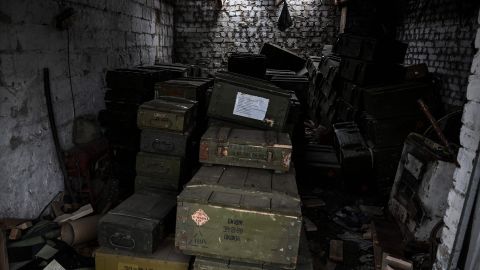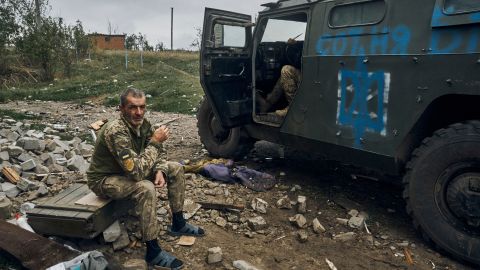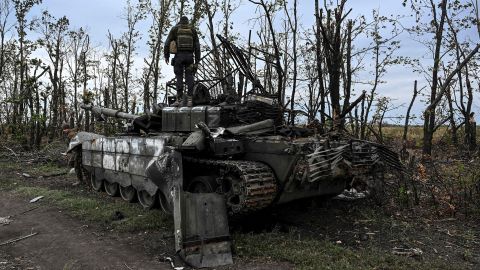Brad Lendon
From Wednesday to Sunday, Vladimir Putin’s military forces saw at least 338 pieces of important military hardware – from fighter jets to tanks to trucks – destroyed, damaged or captured, according to numbers from the open source intelligence website Oryx, as Ukraine’s forces have bolted through Russian-held territory in an offensive that has stunned the Russians in its speed and breadth.
Ukraine’s top military commander claimed on Sunday that more than 3,000 square kilometers (1,158 square miles) of territory had been retaken by his country’s forces since the beginning of September. And for more perspective, just “since Wednesday, Ukraine has recaptured territory at least twice the size of Greater London,” the British Defense Ministry said Monday.
Ukrainian reports say Putin’s troops are fleeing east to the Russian border in whatever transport they can find, even taking cars from the civilian population in the areas they had captured since the start of the war in February.
In their wake they leave hundreds of pieces of the Russian war machine, which since Putin’s so-called “special military operation” commenced, has not come close to living up to its pre-war billing as one of the world’s great powers.
These Russian losses are the accumulation of a multitude of existing problems that are now colliding head-on with a Ukrainian military that has been patient, methodical and infused with billions of dollars of Western military equipment that Russia cannot match.
And without a drastic, and potentially unconventional intervention from Putin, the Ukrainian victories are likely to accelerate, analysts say.
Many of Russia’s problems – poor and inflexible leadership, sour troop morale, inadequate logistics and hardware beset by maintenance issues – have been evident since the beginning stages of the war more than seven months ago.
The Russian military’s hollow core – including tanks that were easy prey for Ukrainian ground troops and trucks that didn’t have the right tires to traverse Ukraine’s landscape – was quickly exposed by tactics ill-suited to the blitzkrieg Putin had planned.
As that convoy stalled, reports filtered out that Russian troops had significant morale problems – some didn’t even know they were in Ukraine, or if they did, why they were there. As the fighting intensified, Ukrainian forces targeted Russian leadership, killing generals and colonels who would have been expected to rally the Russian forces.
And the Russians certainly needed stronger leadership if accounts of troop hardships are to be believed.

An abandoned Russian tank sits in vegetation in a village on the outskirts of Izium, Ukraine, on Sunday.Juan Barreto/AFP/Getty Images
Pavel Filatyev, a Russian paratrooper who fought his army’s capture of the Ukrainian city of Kherson earlier in the war, told CNN last month that his unit lacked even the basics during that operation.
“Several days after we encircled Kherson many of us did not have any food, water or sleeping sacks,” he said. “It was very cold at night, so we couldn’t even sleep. We would find some rubbish, some rags, just to wrap ourselves to keep warm.”
And their armaments were substandard, he said.
“All of our weapons are from the times of Afghanistan,” where Russian forces fought from 1979 to 1989, he said.
Meanwhile, Western arms have flowed into Ukraine, among them powerful advanced artillery systems like the HIMARS, or High Mobility Artillery Rocket Systems.
The wheeled HIMARS offer what US manufacturer Lockheed Martin calls “shoot and scoot capability” – they can fire highly accurate rockets at targets about 70 to 80 kilometers (about 50 miles) away and then move quickly to avoid any counterstrike.
Ukraine has used them with devastating effect on Russian supply lines, ammunition dumps and command posts.
“Ukraine’s armed forces employed HIMARS and other Western systems to attack Russian ground lines of communication in Kharkiv and Kherson Oblasts, setting conditions for the success of this operation,” the Institute for the Study of War (ISW) said in a blog post on Sunday.
According to Western analysts, the pounding meted out by Ukrainian deployed HIMARS on Russian supply lines has been relentless.
“Ukrainian long-range artillery is now probably hitting crossings of the Dnipro (River) so frequently that Russia cannot carry out repairs to damaged road bridges,” Britain’s Defense Ministry said Monday.
Trent Telenko, a former quality control auditor for the US’ Defense Contract Management Agency who has studied Russian logistics, said Ukrainian forces used precision rockets fired from the HIMARS batteries to take out key large Russian arms depots near rail lines well back of the front lines.
This meant Russia had to use trucks to disperse artillery pieces and ammunition to smaller depots, making it more difficult to distribute, Telenko said. He said that when Ukraine began its lightning offensive, Russia could not bring appropriate firepower to blunt the Ukrainian advance because its artillery was so dispersed.
But the HIMARS and other powerful Western artillery systems shouldn’t get all the credit, ISW said. They were coupled with Ukrainian feints and ingenuity.
Last week Russia redeployed forces to the south to bolster its ranks ahead of a mooted Ukrainian counteroffensive in Kherson region, according to Ukrainian officials and footage of equipment moving through Crimea.
That opened the door for Ukrainian forces farther north.

Abandoned Russian munitions lie in a village on the outskirts of Izium, Ukraine, on Sunday.Juan Barreto/AFP/Getty Images
“Kyiv’s long discussion and then an announcement of a counter-offensive operation aimed at Kherson Oblast drew substantial Russian troops away from the sectors on which Ukrainian forces have conducted decisive attacks in the past several days,” ISW said.
Once those Russian forces moved, the Ukrainian military probed for weak points in Russian lines, said Mark Hertling, a CNN analyst and former US Army general.
“What they have been able to do is conduct reconnaissance with a small force to find where to conduct a much larger breakthrough, pushing tanks and artillery through the holes in the Russian front and then getting into the Russian rear areas,” Hertling said.
Supplies for Ukraine to fuel its advance
The quick Russian retreat has enabled Ukraine to capture Russian arms, ammunition, fuel and supplies in those rear areas, said Telenko, adding that the addition of trucks and trains to the Ukrainian inventory will allow Kyiv to “supercharge” its advances.
Analysts have also noted the lack of Russian air support.
Richard Hooker Jr., a nonresident senior fellow with the Atlantic Council, said last month that Ukraine has stitched together a force of older antiaircraft systems already in its inventory with supplies of US and German equipment and “largely sidelined Russian airpower.”
“Ukraine has been outstandingly successful in denying Russia air supremacy with extremely effective air defense and a strategy of ‘air denial,’” Hooper wrote on the Atlantic Council’s “Ukraine Alert” blog.

A Ukrainian soldier takes a break to rest in the freed territory in the Kharkiv region, Ukraine, on Monday.Kostiantyn Liberov/AP
And Russian setbacks are just fuel for even more trouble ahead, a spiral of defeats that may be beyond Moscow’s ability to stop.
Mick Ryan, an adjunct fellow at the Center for Strategic and International Studies and a former Australian Army general, terms it “cascading failure” in a Twitter post. “Each battlefield loss and withdrawal leads to further failure,” he said.
As the options dwindle, so will embattled Russian morale.
As retreating forces return, they’ll bring stories of their withdrawal. It will be all but impossible for the Kremlin to keep those stories from spreading within its forces and even to their relatives back home.
The territory Russia captured in Ukraine over seven months, at the cost of tens of thousands of Russian casualties, has been lost in a week.
And Russia’s generals seemingly have no immediate answer.
Even when Putin’s forces were advancing, those advances were slow and grinding. And earlier in the war, Ukraine’s defenders never fled the way Russian troops have in the past week.
“The already limited trust deployed troops have in Russia’s senior military leadership is likely to deteriorate further,” the British Defense Ministry said on Monday.
The ministry’s report said the Ukrainian attacks had made it difficult for Russia to move replacement troops to the front lines.
Where does Moscow find replacements?
The big question is whether Russia has fresh trained troops to move forward.
In July, CNN reported that the call had gone out across Russia for more than 30,000 volunteers to join the war effort in Ukraine. The lure was big cash bonuses and no experience was necessary.
But Kateryna Stepanenko, a Russia researcher at ISW, said those new recruits would likely be of little help on the battlefield as there would not be enough time to train them.
For instance, training a tank crew can take several months at a minimum and sometimes more than a year, experts say.
“Short-term training is unlikely to turn volunteers with no prior experience into effective soldiers in any unit,” Stepanenko said.
And those 300-plus Russian pieces of hardware left destroyed, damaged or abandoned on the battlefield over the past several days won’t be easy to replace either.

A Ukranian soldier on Sunday standis atop an abandoned Russian tank near a village on the outskirts of Izyum, Ukraine.Juan Barreto/AFP/Getty Images
Russian industry has been hamstrung by Western sanctions. Russian arms depots have already been raided to replace earlier losses. And while large numbers of arms may remain in those depots, they are likely old and in need of repair or refurbishment, said Jakub Janovsky, a military analyst who contributes to the Oryx blog.
“In practice replacements are often much older vehicles – likely to suffer from reliability problems and with lower effectiveness in combat,” he said.
Moscow retains manufacturing capacity, but lacks the best components for what it might make, Janovsky said.
“Due to sanctions they might have to replace sensors and electronics with inferior alternatives – and the amount they can produce in the near term is a fraction of what they are losing. Those material losses … are not sustainable,” he said.
So advantage Ukraine, at least in the near term.
But Ryan, the former Australian general, remains cautious.
“It is too early to speak in overly triumphant terms. The Russians still have the capacity to respond. The south & east are still occupied by the Russians. The Ukrainians have won a significant victory, but there is still a war to be won,” he tweeted.
No comments:
Post a Comment